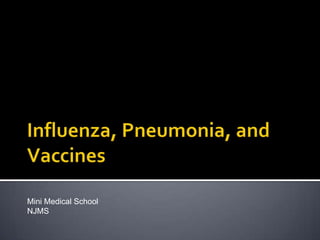
Mini med flu, pneumonia, vaccines
- 2. Understand the clinical aspects of the influenza virus Explore methods of influenza prevention Learn the causes and symptoms of pneumonia Understand the types of vaccines available List the recommendations for vaccination in the US Apply knowledge to a case study
- 3. Influenza, commonly known as “the flu”, is caused by an RNA virus that infects the respiratory tracts of many animals, including humans
- 4. Influenza viruses are divided into three types: A, B, and C Type A is responsible for the annual flu outbreaks, as well as major pandemics On the outer surface of the virus particles are small molecules called Hemagglutinins (H) and Neuraminidases (N) This allows a specific subtype to be classified, i.e. H1N1
- 5. There are many different subtypes of the influenza A virus, but there are only three that are known to be circulating among humans: H1N1, H1N2, and H3N2 Each subtype of influenza virus has many different strains, many of which vary by geographic location As a result, the particular strain that is responsible for the winter “flu season” changes annually
- 6. The influenza virus is spread by coughing, sneezing, talking, or touching surfaces that have the flu virus on them Prevention is key! WASH YOUR HANDS! Symptoms: Fever (usually 100 F-103 F in adults and often even higher in children) Respiratory symptoms such as cough, sore throat, runny or stuffy nose Headache Muscle aches Fatigue Symptoms can last 1-2 weeks These symptoms are worse in elderly and people with chronic health problems
- 7. Treatment: Rest! Drink plenty of fluids Antiviral Medications ▪ Only effective if taken within the first 2 days of getting sick Antibiotics WILL NOT help!
- 8. The changing strains of influenza viruses pose a challenge for developing a vaccine against the flu Each year, the prominent strains that cause infection vary As a result, a flu shot is only effective for that particular season, and must be repeated annually Who is at risk? Senior citizens Children, especially those under age 2 People with chronic health conditions
- 9. A 67-year-old man comes into the ER complaining of difficulty breathing, fatigue, and a cough that produces “yellow stuff”. He had the flu last week, and states that he did not get the flu shot this season because he “never gets sick”. He also reports smoking a pack of cigarettes a day, and has been for the last 50 years. Vital signs: BP: 168/92 Pulse: 128 bpm Respirations: 32, shallow Temperature: 101.3 °F Are these vital signs normal?
- 10. BP: 168/92 – high Pulse: 128 – high Respirations: 32, shallow – high, seems labored Temperature: 101.3 °F – high (fever) What aspects of this patient’s history stand out? What do you suspect might be going on with this patient?
- 11. Pneumonia is a respiratory condition in which there is an infection of the lung The lungs can be infected with viruses, bacteria, or fungi There are many bacteria living in your nose, mouth, and throat These bacteria are called the “normal flora” – they are supposed to be there, and often serve a protective role Some bacteria may end up in places where they should not be, such as the lungs, especially when the body’s defenses are weakened
- 12. Bacteria colonize the lungs and cause the production of pus (“yellow stuff”), which can irritate the lungs and make it difficult to breathe The body tries to fight off the infection, leading to fever, chills, and fatigue
- 13. The patient was given oxygen, and a chest x- ray was ordered. A sputum sample (“yellow stuff”) was collected and cultured. What do you notice about the patient’s chest x-ray?
- 14. Chest X-ray: congestion in the right upper lobe Healthy lungs are clear, and appear black on an X-ray
- 15. The patient’s sputum culture came back positive for Streptococcus pneumoniae Is this patient’s pneumonia due to a virus, bacteria, or fungus?
- 16. The cause of 50% of all bacterial pneumonia Elderly individuals are at high risk for S. pneumoniae infection A vaccine is available, and is recommended for individuals age 65+
- 17. Individuals at risk: Elderly Smokers Alcoholics Young children Those with a recent viral infection Those who live in a nursing home Treatment: Antibiotics
- 18. The patient was given antibiotics and was able to return home after 3 days in the hospital. The doctors advised the patient to quit smoking, and gave him the number of a local pharmacy that offers vaccinations
- 19. A vaccine is a biological preparation that improves immunity to a particular disease A vaccine typically contains an agent that resembles a disease-causing microorganism, which stimulates the immune system to recognize it as foreign and destroy it The immune system is capable of “remembering” the agent, and is thus able to recognize and destroy any of these microorganisms that it later encounters
- 20. There are 4 types of vaccines: Killed: Contain killed, but previously virulent, micro- organisms that have been destroyed with chemicals, heat, radioactivity or antibiotics (i.e. the influenza vaccine) Attenuated: Contain live, attenuated microorganisms that have been cultivated under conditions that disable their virulent properties (i.e. the measles vaccine) Toxoid: made from inactivated toxic compounds that cause illness (i.e. the tetanus toxoid) Subunit: made from a protein subunit from part of the microorganism (i.e. the hepatitis B vaccine)
